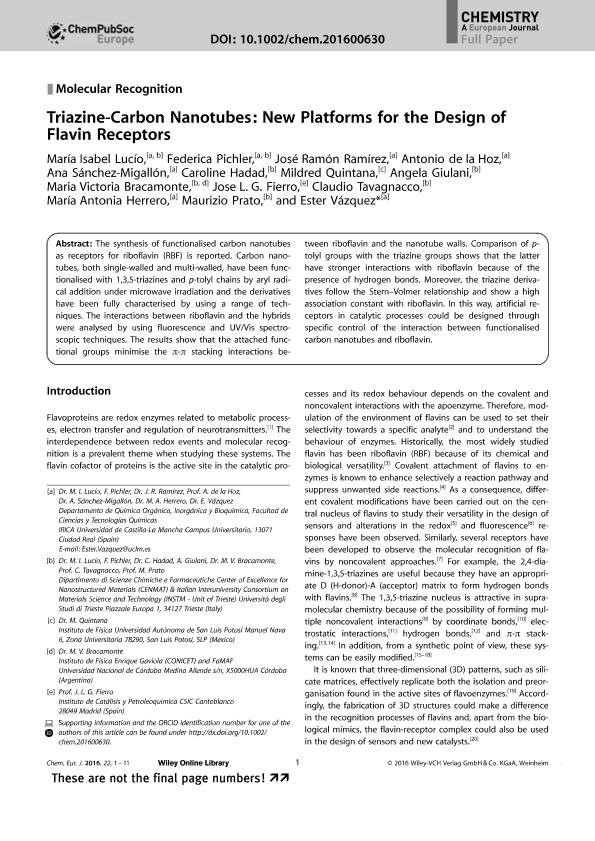Artículo
Triazine-Carbon Nanotubes: New Platforms for the Design of Flavin Receptors
Lucío, María Isabel; Pichler, Federica; Ramírez, José Ramón; de la Hoz, Antonio; Sánchez Migallón, Ana; Hadad, Caroline; Quintana, Mildred; Giulani, Angela; Bracamonte, Maria Victoria ; Fierro, Jose L.G.; Tavagnacco, Claudio; Herrero, María Antonia; Prato, Maurizio; Vázquez, Ester
; Fierro, Jose L.G.; Tavagnacco, Claudio; Herrero, María Antonia; Prato, Maurizio; Vázquez, Ester
 ; Fierro, Jose L.G.; Tavagnacco, Claudio; Herrero, María Antonia; Prato, Maurizio; Vázquez, Ester
; Fierro, Jose L.G.; Tavagnacco, Claudio; Herrero, María Antonia; Prato, Maurizio; Vázquez, Ester
Fecha de publicación:
05/2016
Editorial:
Wiley Vch Verlag
Revista:
Chemistry- A European Journal
ISSN:
0947-6539
Idioma:
Inglés
Tipo de recurso:
Artículo publicado
Clasificación temática:
Resumen
The synthesis of functionalised carbon nanotubes as receptors for riboflavin (RBF) is reported. Carbon nanotubes, both single-walled and multi-walled, have been functionalised with 1,3,5-triazines and p-tolyl chains by aryl radical addition under microwave irradiation and the derivatives have been fully characterised by using a range of techniques. The interactions between riboflavin and the hybrids were analysed by using fluorescence and UV/Vis spectroscopic techniques. The results show that the attached functional groups minimise the p-p stacking interactions between riboflavin and the nanotube walls. Comparison of ptolyl groups with the triazine groups shows that the latter have stronger interactions with riboflavin because of the presence of hydrogen bonds. Moreover, the triazine derivatives follow the Stern–Volmer relationship and show a high association constant with riboflavin. In this way, artificial receptors in catalytic processes could be designed through specific control of the interaction between functionalised carbon nanotubes and riboflavin
Archivos asociados
Licencia
Identificadores
Colecciones
Articulos(IFEG)
Articulos de INST.DE FISICA ENRIQUE GAVIOLA
Articulos de INST.DE FISICA ENRIQUE GAVIOLA
Citación
Lucío, María Isabel; Pichler, Federica; Ramírez, José Ramón; de la Hoz, Antonio; Sánchez Migallón, Ana; et al.; Triazine-Carbon Nanotubes: New Platforms for the Design of Flavin Receptors; Wiley Vch Verlag; Chemistry- A European Journal; 22; 26; 5-2016; 8879-8888
Compartir
Altmétricas



